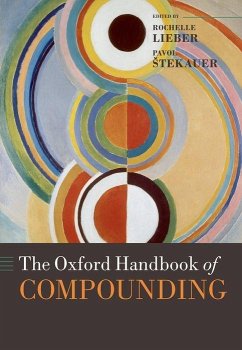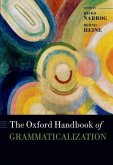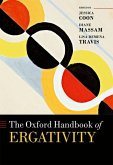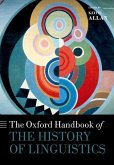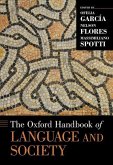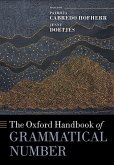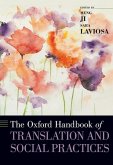Oxford Handbook of Compounding
Herausgeber: Lieber, Rochelle; Stekauer, Pavol
Oxford Handbook of Compounding
Herausgeber: Lieber, Rochelle; Stekauer, Pavol
- Gebundenes Buch
- Merkliste
- Auf die Merkliste
- Bewerten Bewerten
- Teilen
- Produkt teilen
- Produkterinnerung
- Produkterinnerung
This book presents a comprehensive review of theoretical work on the linguistics and psycholinguistics of compound words and combines it with a series of surveys of compounding in a variety of languages from a wide range of language families.
Andere Kunden interessierten sich auch für
![Oxford Handbook of Grammaticalization Oxford Handbook of Grammaticalization]() Oxford Handbook of Grammaticalization251,99 €
Oxford Handbook of Grammaticalization251,99 €![The Oxford Handbook of Construction Grammar The Oxford Handbook of Construction Grammar]() Thomas HoffmannThe Oxford Handbook of Construction Grammar234,99 €
Thomas HoffmannThe Oxford Handbook of Construction Grammar234,99 €![The Oxford Handbook of Ergativity The Oxford Handbook of Ergativity]() The Oxford Handbook of Ergativity223,99 €
The Oxford Handbook of Ergativity223,99 €![Oxford Handbook of the History of Linguistics Oxford Handbook of the History of Linguistics]() Oxford Handbook of the History of Linguistics228,99 €
Oxford Handbook of the History of Linguistics228,99 €![The Oxford Handbook of Language and Society The Oxford Handbook of Language and Society]() The Oxford Handbook of Language and Society234,99 €
The Oxford Handbook of Language and Society234,99 €![The Oxford Handbook of Grammatical Number The Oxford Handbook of Grammatical Number]() The Oxford Handbook of Grammatical Number251,99 €
The Oxford Handbook of Grammatical Number251,99 €![The Oxford Handbook of Translation and Social Practices The Oxford Handbook of Translation and Social Practices]() The Oxford Handbook of Translation and Social Practices223,99 €
The Oxford Handbook of Translation and Social Practices223,99 €-
-
-
This book presents a comprehensive review of theoretical work on the linguistics and psycholinguistics of compound words and combines it with a series of surveys of compounding in a variety of languages from a wide range of language families.
Hinweis: Dieser Artikel kann nur an eine deutsche Lieferadresse ausgeliefert werden.
Hinweis: Dieser Artikel kann nur an eine deutsche Lieferadresse ausgeliefert werden.
Produktdetails
- Produktdetails
- Verlag: Oxford University Press (UK)
- Seitenzahl: 712
- Erscheinungstermin: 25. März 2009
- Englisch
- Abmessung: 251mm x 181mm x 41mm
- Gewicht: 1248g
- ISBN-13: 9780199219872
- ISBN-10: 0199219877
- Artikelnr.: 26624135
- Herstellerkennzeichnung
- Libri GmbH
- Europaallee 1
- 36244 Bad Hersfeld
- gpsr@libri.de
- Verlag: Oxford University Press (UK)
- Seitenzahl: 712
- Erscheinungstermin: 25. März 2009
- Englisch
- Abmessung: 251mm x 181mm x 41mm
- Gewicht: 1248g
- ISBN-13: 9780199219872
- ISBN-10: 0199219877
- Artikelnr.: 26624135
- Herstellerkennzeichnung
- Libri GmbH
- Europaallee 1
- 36244 Bad Hersfeld
- gpsr@libri.de
Rochelle Lieber is Professor of Linguistics in the English Department of the University of New Hampshire. She is the author of On the Organization of the Lexicon (1981), An Integrated Theory of Autosegmental Processes (1987), Deconstructing Morphology (1992), and Morphology and Lexical Semantics (2004). She is co-Editor in Chief of Blackwell's Language and Linguistics Compass. Pavol Stekauer is Professor of English linguistics in the Department of British and US Studies, Safárik University, Kosice, Slovakia. He is the author of A Theory of Conversion in English (Frankfurt am Main: Peter Lang, 1996), An Onomasiological Theory of English Word-Formation (1998), and English Word-Formation: A History of Research (2000), and Meaning Predictability in Word-Formation (2005) Professor Lieber and Professor Stekauer are joint editors of A Handbook of Word-Formation (2005).
* Part I:
* 1: Rochelle Lieber and Pavol Stekauer: Introduction: Status and
Definition of Compounding
* 2: Stanislav Kavka: Compounding and Idiomatology
* 3: Antonietta Bisetto and Sergio Scalise: The Classification of
Compounds
* 4: Pius ten Hacken: Early Generative Approaches
* 5: Rochelle Lieber: A Lexical Semantic Approach to Compounding
* 6: Ray Jackendoff: Compounding in the Parallel Architecture and
Conceptual Semantics
* 7: Heidi Harley: Compounding in Distributed Morphology
* 8: Anna Maria Di Scuillo: Why are Compounds a Part of Human Language?
A View from Asymmetry Theory
* 9: Heinz Giegerich: Compounding and Lexicalism
* 10: Geert Booij: Compounding and Construction Morphology
* 11: Joachim Grzega: Compounding from an Onomasiological Perspective
* 12: Liesbet Heyvaert: Compounding in Cognitive Linguistics
* 13: Christina L. Gagné: Psycholinguistic Perspectives
* 14: Pavol Stekauer: Meaning Predictability of Novel Context-free
Compounds
* 15: Ruth Berman: Children's Acquisition of Compound Constructions
* 16: Dieter Kastovsky: Diachronic Perspectives
* Part II
* 17: Laurie Bauer: Typology of Compounds
* 18: Rochelle Lieber: IE, Germanic: English
* 19: Jan Don: IE, Germanic: Dutch
* 20: Martin Neef: IE, Germanic: German
* 21: Laurie Bauer: . IE, Germanic: Danish
* 22: Bernard Fradin: IE, Romance: French
* 23: Laura Malena Kornfeld: IE, Romance: Spanish
* 24: Angela Ralli: IE, Hellenic: Modern Greek
* 25: Bogdan Szymanek: IE, Slavonic: Polish
* 26: Antonella Ceccagno and Bianca Basciano: Sino-Tibetan: Mandarin
Chinese
* 27: Hagit Borer: Afro-Asiatic, Semitic: Hebrew
* 28: Taro Kageyama: Isolate: Japanese
* 29: Ferenc Kiefer: Uralic, Finno-Ugric: Hungarian
* 30: Keren Rice: Athapaskan: Slave
* 31: Marianne Mithun: Iroquoian: Mohawk
* 32: Raoul Zamponi: Arawakan: Maipure-Yavitero
* 33: Mark C. Baker and Carlos A. Fasola: Araucanian: Mapudungun
* 34: Jane Simpson: Pama-Nyungan: Warlpiri
* References
* Index
* 1: Rochelle Lieber and Pavol Stekauer: Introduction: Status and
Definition of Compounding
* 2: Stanislav Kavka: Compounding and Idiomatology
* 3: Antonietta Bisetto and Sergio Scalise: The Classification of
Compounds
* 4: Pius ten Hacken: Early Generative Approaches
* 5: Rochelle Lieber: A Lexical Semantic Approach to Compounding
* 6: Ray Jackendoff: Compounding in the Parallel Architecture and
Conceptual Semantics
* 7: Heidi Harley: Compounding in Distributed Morphology
* 8: Anna Maria Di Scuillo: Why are Compounds a Part of Human Language?
A View from Asymmetry Theory
* 9: Heinz Giegerich: Compounding and Lexicalism
* 10: Geert Booij: Compounding and Construction Morphology
* 11: Joachim Grzega: Compounding from an Onomasiological Perspective
* 12: Liesbet Heyvaert: Compounding in Cognitive Linguistics
* 13: Christina L. Gagné: Psycholinguistic Perspectives
* 14: Pavol Stekauer: Meaning Predictability of Novel Context-free
Compounds
* 15: Ruth Berman: Children's Acquisition of Compound Constructions
* 16: Dieter Kastovsky: Diachronic Perspectives
* Part II
* 17: Laurie Bauer: Typology of Compounds
* 18: Rochelle Lieber: IE, Germanic: English
* 19: Jan Don: IE, Germanic: Dutch
* 20: Martin Neef: IE, Germanic: German
* 21: Laurie Bauer: . IE, Germanic: Danish
* 22: Bernard Fradin: IE, Romance: French
* 23: Laura Malena Kornfeld: IE, Romance: Spanish
* 24: Angela Ralli: IE, Hellenic: Modern Greek
* 25: Bogdan Szymanek: IE, Slavonic: Polish
* 26: Antonella Ceccagno and Bianca Basciano: Sino-Tibetan: Mandarin
Chinese
* 27: Hagit Borer: Afro-Asiatic, Semitic: Hebrew
* 28: Taro Kageyama: Isolate: Japanese
* 29: Ferenc Kiefer: Uralic, Finno-Ugric: Hungarian
* 30: Keren Rice: Athapaskan: Slave
* 31: Marianne Mithun: Iroquoian: Mohawk
* 32: Raoul Zamponi: Arawakan: Maipure-Yavitero
* 33: Mark C. Baker and Carlos A. Fasola: Araucanian: Mapudungun
* 34: Jane Simpson: Pama-Nyungan: Warlpiri
* References
* Index
* Part I:
* 1: Rochelle Lieber and Pavol Stekauer: Introduction: Status and
Definition of Compounding
* 2: Stanislav Kavka: Compounding and Idiomatology
* 3: Antonietta Bisetto and Sergio Scalise: The Classification of
Compounds
* 4: Pius ten Hacken: Early Generative Approaches
* 5: Rochelle Lieber: A Lexical Semantic Approach to Compounding
* 6: Ray Jackendoff: Compounding in the Parallel Architecture and
Conceptual Semantics
* 7: Heidi Harley: Compounding in Distributed Morphology
* 8: Anna Maria Di Scuillo: Why are Compounds a Part of Human Language?
A View from Asymmetry Theory
* 9: Heinz Giegerich: Compounding and Lexicalism
* 10: Geert Booij: Compounding and Construction Morphology
* 11: Joachim Grzega: Compounding from an Onomasiological Perspective
* 12: Liesbet Heyvaert: Compounding in Cognitive Linguistics
* 13: Christina L. Gagné: Psycholinguistic Perspectives
* 14: Pavol Stekauer: Meaning Predictability of Novel Context-free
Compounds
* 15: Ruth Berman: Children's Acquisition of Compound Constructions
* 16: Dieter Kastovsky: Diachronic Perspectives
* Part II
* 17: Laurie Bauer: Typology of Compounds
* 18: Rochelle Lieber: IE, Germanic: English
* 19: Jan Don: IE, Germanic: Dutch
* 20: Martin Neef: IE, Germanic: German
* 21: Laurie Bauer: . IE, Germanic: Danish
* 22: Bernard Fradin: IE, Romance: French
* 23: Laura Malena Kornfeld: IE, Romance: Spanish
* 24: Angela Ralli: IE, Hellenic: Modern Greek
* 25: Bogdan Szymanek: IE, Slavonic: Polish
* 26: Antonella Ceccagno and Bianca Basciano: Sino-Tibetan: Mandarin
Chinese
* 27: Hagit Borer: Afro-Asiatic, Semitic: Hebrew
* 28: Taro Kageyama: Isolate: Japanese
* 29: Ferenc Kiefer: Uralic, Finno-Ugric: Hungarian
* 30: Keren Rice: Athapaskan: Slave
* 31: Marianne Mithun: Iroquoian: Mohawk
* 32: Raoul Zamponi: Arawakan: Maipure-Yavitero
* 33: Mark C. Baker and Carlos A. Fasola: Araucanian: Mapudungun
* 34: Jane Simpson: Pama-Nyungan: Warlpiri
* References
* Index
* 1: Rochelle Lieber and Pavol Stekauer: Introduction: Status and
Definition of Compounding
* 2: Stanislav Kavka: Compounding and Idiomatology
* 3: Antonietta Bisetto and Sergio Scalise: The Classification of
Compounds
* 4: Pius ten Hacken: Early Generative Approaches
* 5: Rochelle Lieber: A Lexical Semantic Approach to Compounding
* 6: Ray Jackendoff: Compounding in the Parallel Architecture and
Conceptual Semantics
* 7: Heidi Harley: Compounding in Distributed Morphology
* 8: Anna Maria Di Scuillo: Why are Compounds a Part of Human Language?
A View from Asymmetry Theory
* 9: Heinz Giegerich: Compounding and Lexicalism
* 10: Geert Booij: Compounding and Construction Morphology
* 11: Joachim Grzega: Compounding from an Onomasiological Perspective
* 12: Liesbet Heyvaert: Compounding in Cognitive Linguistics
* 13: Christina L. Gagné: Psycholinguistic Perspectives
* 14: Pavol Stekauer: Meaning Predictability of Novel Context-free
Compounds
* 15: Ruth Berman: Children's Acquisition of Compound Constructions
* 16: Dieter Kastovsky: Diachronic Perspectives
* Part II
* 17: Laurie Bauer: Typology of Compounds
* 18: Rochelle Lieber: IE, Germanic: English
* 19: Jan Don: IE, Germanic: Dutch
* 20: Martin Neef: IE, Germanic: German
* 21: Laurie Bauer: . IE, Germanic: Danish
* 22: Bernard Fradin: IE, Romance: French
* 23: Laura Malena Kornfeld: IE, Romance: Spanish
* 24: Angela Ralli: IE, Hellenic: Modern Greek
* 25: Bogdan Szymanek: IE, Slavonic: Polish
* 26: Antonella Ceccagno and Bianca Basciano: Sino-Tibetan: Mandarin
Chinese
* 27: Hagit Borer: Afro-Asiatic, Semitic: Hebrew
* 28: Taro Kageyama: Isolate: Japanese
* 29: Ferenc Kiefer: Uralic, Finno-Ugric: Hungarian
* 30: Keren Rice: Athapaskan: Slave
* 31: Marianne Mithun: Iroquoian: Mohawk
* 32: Raoul Zamponi: Arawakan: Maipure-Yavitero
* 33: Mark C. Baker and Carlos A. Fasola: Araucanian: Mapudungun
* 34: Jane Simpson: Pama-Nyungan: Warlpiri
* References
* Index

